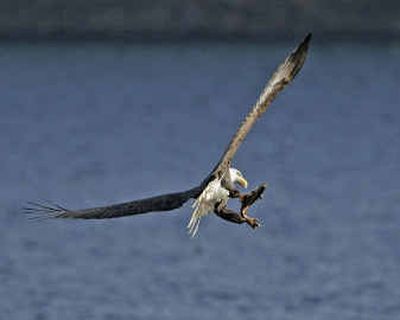Birdwatchers set their sights on annual Christmas Bird Count

Birdwatchers in this region and across the continent will flock together in the next few weeks for the Audubon Society’s Christmas Bird Count, the annual birding social event of the season.
But birdwatchers themselves have been known to stand up and be counted as citizens with insight into the environment.
The National Audubon Society, which will be celebrating its 100th anniversary next year, was founded primarily by women who had organized to pluck the feathers from a fashion trend in women’s hats that was leading to the decimation of certain wild bird species.
In what history might rank as a peripherally related event, the Christmas Bird Count began on Christmas 1900, when 27 conservationists in 25 localities posed an alternative to the “side hunt,” a traditional Christmas activity in which teams competed to see who could shoot the most birds and small mammals.
Instead, these birders publicized the pleasure of identifying, counting and recording all the birds they saw, founding what is now considered to be one of the world’s broadest-based citizen conservation efforts.
Apart from its main attraction as a social and competitive event, the databases facilitated by on-line reporting have boosted the Christmas count’s value in monitoring the status of resident and migratory birds across the Western Hemisphere, Audubon officers say.
The volunteer-generated data is combined with more scientific survey methods to help ornithologists study myriad issues, such as the magnitude of West Nile virus.
This fall, the Audubon Society compiled data from various bird surveys into a 2004 State of the Birds report that serves as a wake-up call to every niche of society.
The bird-advocacy group analyzed data from 1966 to 2003 for 654 bird species that live in grasslands, shrublands, forests, urban areas and waterways.
According to the report, almost 30 percent of North America’s bird species are in “significant decline.” The overall state of the birds shows significant declines in 70 percent of grassland species, 36 percent of shrubland species, 25 percent of forest species, 13 percent of wetland species and 23 percent of bird species in urban areas.
The declines are not normal, the report says and are attributed to a loss of native grasslands, overgrazing, development of wetlands, invasive species, pollution, pesticides, among other factors.
Even the Western meadowlark, Oregon’s state bird, is among the declining species.
“We have more intensive agriculture than we did,” said Dave Eshbaugh, state director of Audubon Oregon. “The grasshopper sparrow, for example, relies on bunchgrass, which gets converted into fields. As farmers are more economically stressed, they push the margins of their fields.”
Still, birders say they are encouraged by survey finding that next to gardening, birdwatching is one of the country’s most popular outdoors activities.
Backyard bird feeding and birdwatching is easy, accessible and appealing to virtually every age group.
But the Christmas Bird Count is an event that lures even fledgling birders into the field.
More than 55,000 volunteers from all 50 states, Canada, parts of Central and South America, Bermuda, the West Indies, and Pacific Islands are expected to participate in the count this year.
Last year, about 63 million birds were counted.
Dozens of groups are being organized in the Inland Northwest alone. Each group counts for one day between Dec. 14 and Jan. 5 in a designated circle 15 miles in diameter.
Idahoans have been participating since 1914, when the state’s first Christmas Bird Count was organized in Moscow, said Shirley Sturts of Audubon’s Coeur d’Alene chapter.
Three participants counted eight species of birds that year, she said.
This year, North Idaho will have at least six groups involving dozens of participants counting dozens of species and sending the results to the national database.
“New birders are always welcome to join the counts,” said Alan McCoy, coordinator for the Spokane count.
“Last year we set several records for numbers of species and new species to the count,” said Doug Schonewald, compiler for the Moses Lake count. “This was accomplished in spite of difficult weather conditions.”
“What we see depends on the year and the weather,” said Jerry Cline, who coordinates the Colville count and works at the Little Pend Oreille National Wildlife Refuge.
He said he never knows what species will “erupt” in the counting area, with one exception: “Wild turkeys have become so numerous in recent years, we’re thinking about changing the name of the event to the Christmas Turkey Count.”